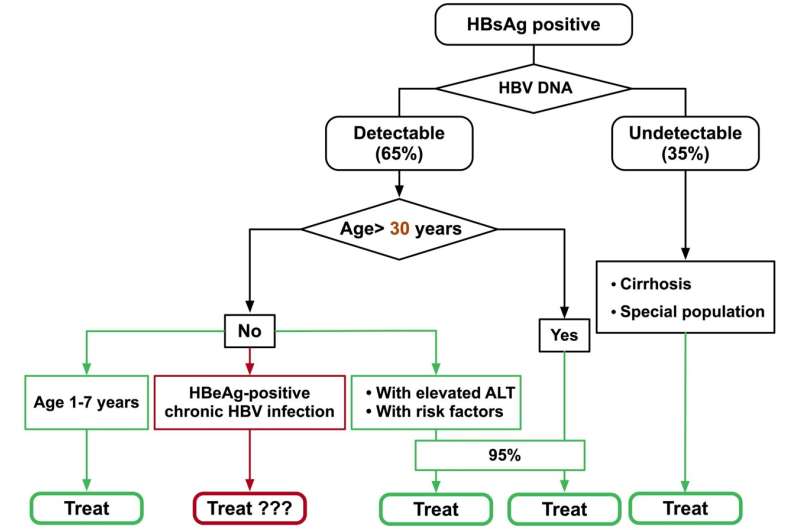This article has been reviewed according to Science X's editorial process and policies. Editors have highlighted the following attributes while ensuring the content's credibility:
fact-checked
proofread
'Treat-all' strategy for patients with chronic hepatitis B virus infection in China: Are we there yet?

Chronic hepatitis B (CHB) remains a significant global health issue, particularly in regions like China where the prevalence is high. Addressing this challenge, the 2022 Chinese guidelines for the prevention and treatment of CHB introduced a more proactive approach. These guidelines expand treatment indications and simplify algorithms to enhance disease management.
A study by Mengyang Zhang and colleagues, published in the Journal of Clinical and Translational Hepatology interprets these guidelines and explores the implications of a "Treat-all" strategy for CHB management.
The review begins by highlighting the substantial burden of CHB. Untreated CHB can lead to severe liver diseases, including cirrhosis and hepatocellular carcinoma (HCC). The burden is particularly high in China, where HBV infection is a leading cause of liver-related morbidity and mortality. Despite advancements in vaccination and antiviral treatments, the diagnosis and treatment rates remain low, hindering efforts to control the disease.
The "Treat-all" strategy proposed in the new guidelines advocates for treating all patients with detectable HBV DNA or positive HBsAg. This approach aims to reduce the disease burden by preventing progression to more severe liver diseases.
Early treatment can improve the quality of life, reduce infectivity, and address comorbidities like fatty liver disease and HBV reactivation due to immunosuppressive therapies. The strategy is supported by evidence suggesting that early antiviral therapy can prevent liver disease progression and reduce HCC incidence.
The 2022 Chinese guidelines for CHB represent a significant shift towards more proactive management. The guidelines expand the criteria for antiviral treatment to include nearly all patients with detectable HBV DNA, especially those at high risk of disease progression. This includes:
- Adults over 30 with detectable HBV DNA: Recommended for treatment due to the increased risk of disease progression and HCC in this age group.
- Children aged 1-7 with detectable HBV DNA: Pediatric patients are recommended for treatment due to higher rates of achieving functional cure and significant liver injury.
- At-risk adults with detectable HBV DNA: Those with elevated ALT, cirrhosis, significant fibrosis, extrahepatic manifestations, or a family history of HCC are advised to start early treatment.
A key discussion in the review is the controversy over treating patients with HBeAg-positive chronic HBV infection. Traditionally, this phase was not an immediate indication for treatment due to the assumption of minimal liver damage. However, recent studies have shown significant histological damage even in this phase, challenging the traditional approach. Early antiviral treatment in these patients can prevent disease progression and reduce HCC risk, which remains high even in the HBeAg-positive phase.
The review underscores the cost-effectiveness of early treatment initiation. Utilizing a decision-tree Markov state-transition model, researchers demonstrated that expanding antiviral treatment to all HBsAg-positive patients could significantly reduce liver-related events and overall health care costs. This approach aligns with the global health targets set by the World Health Organization (WHO), which aims for a 65% reduction in HBV-related mortality by expanding treatment coverage.
While the "Treat-all" strategy holds promise, it also presents challenges. These include the potential for overtreatment in patients without evident liver injury, ensuring long-term adherence to antiviral therapy, and managing the risks associated with treatment withdrawal, such as viral relapse and liver failure. The review calls for further research and continuous adaptation of strategies to address these challenges and improve patient outcomes.
The 2022 Chinese CHB guidelines mark a significant advancement towards more proactive and comprehensive management of chronic hepatitis B. The "Treat-all" strategy, despite its challenges, has the potential to significantly reduce the burden of HBV-related liver diseases and contribute to the elimination of hepatitis B as a public health threat by 2030.
The research by Zhang provides a thorough analysis of these guidelines, emphasizing the importance of early treatment and the benefits and challenges of a broader antiviral treatment approach.
More information: Mengyang Zhang et al, "Treat-all" Strategy for Patients with Chronic Hepatitis B Virus Infection in China: Are We There Yet?, Journal of Clinical and Translational Hepatology (2024). DOI: 10.14218/JCTH.2024.00091



















